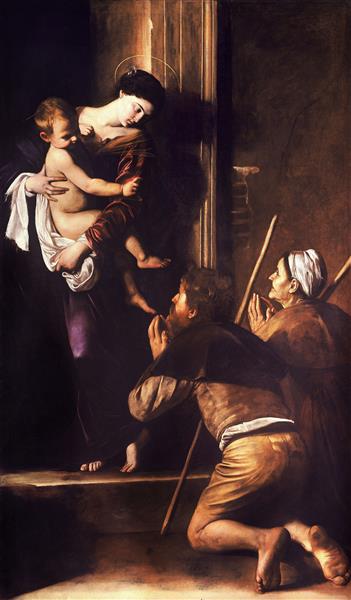Description
Caravaggio's painting "Madonna of Loreto" (1604) is a work that eloquently demonstrates the artist's mastery of chiaroscuro and his exceptional ability to capture human nature. In this work, Caravaggio depicts the Virgin Mary holding the infant Jesus, placed in an environment that evokes devotion and intimacy. The figure of the Virgin is at the same time monumental and immensely accessible; her face, illuminated by a soft but incisive light, reflects a serene sweetness, a characteristic feature of Caravaggio's iconography.
The composition of the work is notable for its dynamic organization. The Virgin is the central axis, and her figure is arranged so that her blue cloak stands out against the darker background. The cloak, which seems to flow with an almost supernatural elegance, creates a contrast that not only accentuates the sacred figure but also gives her a sense of movement, as if she were in a liturgical space in which holiness was invoked. The color blue, which is typically associated with divinity and nobility, is a symbol that elevates the representation of the Virgin.
At Mary's feet are two figures who add a touch of humanity to the scene. These figures, who are devout, are imploring her intercession. This act of supplication not only establishes a connection between the divine and the human, but also represents the role of the Virgin as mediator, a recurring theme in Renaissance and Baroque religious art. The expressions on the faces of the devotees, which show a mixture of reverence and hope, are a magnificent example of Caravaggio's talent for infusing life and emotion into his characters.
Light in Madonna of Loreto is a fundamental tool in visual narrative. Caravaggio makes light a character in its own right, casting a soft glow that envelops the Madonna and Child. This play of light and shadow not only enhances the three-dimensionality of the figures, but also guides the viewer's gaze from the Madonna to the devotees, establishing a visual hierarchy that reflects the spiritual relationship depicted in the work.
It is interesting to note that this painting was commissioned for the church of San Luigi dei Francesi in Rome, a context that further enhances its significance. The work was not only created as an object of private devotion, but also seeks to capture the public’s attention, inviting an experience of contemplation and supplication. In this sense, Caravaggio does not simply represent the sacred; he activates it and makes it tangible, engaging viewers in a spiritual dialogue.
"The Virgin of Loreto" thus fits into the tradition of Baroque art, in which emotion and drama are paramount. Its focus on the direct and emotional representation of the religious echoes other works by Caravaggio, such as "The Calling of Saint Matthew" or "Judith Beheading Holofernes," where human drama and the invocation of divinity are masterfully intertwined. The combination of realism, emotion and the innovative use of light make this painting not only a testament to Caravaggio's genius, but also a reflection of the tumultuous cultural and religious changes of his time.
In conclusion, “Virgin of Loreto” is much more than a simple religious portrait; it is a rich and complex expression of the interaction between the human and the divine, a work that, through its composition, use of color, and emotional charge, invites us to reconsider our perceptions about faith and reverence. In every glance at this painting, one can experience not only Caravaggio’s technical mastery, but also the depth of the message that this work contains.
KUADROS ©, a famous painting on your wall.
Hand-made oil painting reproductions, with the quality of professional artists and the distinctive seal of KUADROS ©.
Painting reproduction service with satisfaction guarantee. If you are not completely satisfied with the replica of your painting, we will refund 100% of your money.

